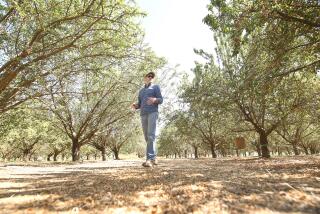Poet’s Chestnut Tree Could Spread Again : Scientists pin hopes on synthetic virus that may fend off fungus that destroyed billions of trees.
- Share via
For many Americans, the line “under the spreading chestnut tree” evokes memories of ninth-grade literature class, not the tree itself.
That’s because the American chestnut, a majestic tree prized for its shade and beautiful hardwood, became virtually extinct by the early 1950s after five decades of blight. The chestnuts raised in nurseries now are Asian varieties, and at holidays, any “chestnuts roasting on an open fire” are likely to be European imports.
And yet, tree lovers and researchers have not given up on the tree that sheltered the village smithy in Longfellow’s poem. Ever since 1904, when the first American chestnuts began dying from a virulent fungus, scientists have been looking for an antidote.
The search may be greatly advanced by a treatment developed by two researchers at the Roche Institute of Molecular Biology in New Jersey. Scientists Gil H. Choi and Donald L. Nuss say they have found a way to produce synthetic viruses that fend off the deadly fungus; if successful, the treatment could help bring back the chestnut and even perhaps the elm tree, which has been decimated by Dutch elm disease.
As many as 4 billion American chestnut trees were killed by the fungus, which scientists believe was unknowingly imported to this country with Chinese chestnuts slated for planting at the Bronx Zoological Park. Before that, the American chestnut had played an important role in U.S. history.
The chestnut was the heart of many Eastern hardwood forests. In the Appalachian Mountains, at least one of every four trees was a chestnut. When the chestnuts’ long, feathery flowers bloomed white in July and August, the ridges of Appalachia looked as though they had been draped in snow.
Natives and early settlers feasted on its small, sweet nuts. Its bark was used to tan leather. Its wood, valued for its durability and resistance to rot, framed the expansion of a growing country west from the Atlantic seaboard. When pioneers crossed the Mississippi and out of the tree’s natural range, they carried saplings with them; later pioneers traveled over railroad ties made from chestnut.
“There’s not another tree as versatile as the American Chestnut,” said William MacDonald, a plant pathologist at the West Virginia University College of Agriculture and Forestry, whose research involves biological controls of the chestnut blight.
To many, the chestnut is the East’s equivalent of the redwood. When found in large stands, as throughout the Appalachians, chestnut trees were “remarkably straight,” said MacDonald.
Often, as they climbed to reach the sun, the trees would grow to 120 to 140 feet tall. Given enough breathing room, though, the chestnut tree would sprawl out its branches; it must have been such an open-space tree that inspired Henry Wadsworth Longfellow in 1842.
From the Chinese imports, the chestnut blight spread rapidly. And by the 1950s, nearly every mature American chestnut tree had fallen victim. But because the fungus cannot survive in soil, root systems and stumps remained, periodically sending out shoots. Before long, however, the young trees are also killed by the fungus.
These root systems are the seat of hope for the scientists and chestnut-lovers.
But, MacDonald said, “the root systems basically will not survive without something above ground, such as a sprout. The sprouts only seem to exist where enough light is getting through the forest canopy. Many sites we could go to, there’s a complete canopy--little light getting through--and probably the chestnut is extinct there. At other sites, the tree does survive.”
It had been known for many years that certain viruses helped reduce the deadly effects of chestnut fungus. Researchers Nuss and Choi, the team at Hoffmann-La Roche’s Nutley, N.J., research center, used that knowledge and genetic engineering to develop a virus that is more potent against the fungus.
It is an especially significant breakthrough, MacDonald and other experts said, because the virus, which causes the fungus to become benign, is passed along through the reproductive cycle to future generations of the fungi.
The team has applied to the U.S. Department of Agriculture for permission to conduct greenhouse and field trials of the synthetic viruses on American chestnuts. It could be another five years before the trials, if approved, are completed and development of a commercial product is begun.
In the meantime, research on the chestnut tree continues, some funded by the popular American Chestnut Foundation.
MacDonald of West Virginia acknowledged that even if a cure to the blight is found, challenges still face the dream of bringing back the chestnut. “The chestnuts have been replaced (by other trees) on most sites,” he said.
“But the chestnut is a really aggressive tree and will move into a site and spread fairly rapidly--in biological time, not human years--and develop quite successfully on sites, given an opportunity to grow without blight.”
And perhaps then, the chestnuts will inspire yet another generation of poets.
More to Read
Sign up for Essential California
The most important California stories and recommendations in your inbox every morning.
You may occasionally receive promotional content from the Los Angeles Times.










